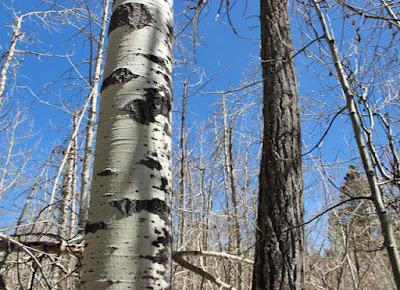 For those in cooler climates who follow deciduous trees, this time year is often spent searching for alternative news. Our trees still show no evidence of change, at least not externally. That was the case when I visited my poplar and aspen last week. So I pondered their bark, which is more interesting than one might first think. The two trees are close relatives, both in the genus Populus. Yet they have very different bark strategies.
For those in cooler climates who follow deciduous trees, this time year is often spent searching for alternative news. Our trees still show no evidence of change, at least not externally. That was the case when I visited my poplar and aspen last week. So I pondered their bark, which is more interesting than one might first think. The two trees are close relatives, both in the genus Populus. Yet they have very different bark strategies.
Populus balsamifera, balsam poplar (I'm pretty sure).

Populus tremuloides, quaking aspen.
We all know bark is the outermost layer of a mature tree trunk. But how does it form and why? Here's a diagram and explanation for those whose memory of plant anatomy is a bit fuzzy (like mine was).From Idaho Forest Products, modified.
Bark is composed of dead cells from the cambium—the very thin layer of living cells between a tree's bark and the wood inside. The cambium layer is where the trunk and branches increase in diameter.Cambium cells divide to produce vascular tissue—xylem and phloem. The xylem and youngest sapwood (sometimes considered equivalent) transport water and nutrients up the tree from the roots. Dead xylem cells accumulate to become wood inside the tree.
In contrast, the phloem transports energy-rich sugars down from photosynthesizing leaves to the rest of the tree. Dead phloem cells accumulate to become bark. These cells are often impregnated with protective substances, like strengthening lignin, waxy suberin, or pest-deterring tannins. The result typically is a thick tough textured covering. See Wikipedia for more about the complicated and variable process of bark formation.
Now back to our visit to the two Populus trees. There was still plenty snow on the shaded trail. Some if it had turned to dicey ice, but all in all it was a fine hike.

Oh dear! Did something happen to my field assistant? Why is she lying down?
No worries! She was just squirming in ecstasy on the hard-packed snow. This endears her to everyone who comes along ... we should all be so happy :)
Enough snow had melted to allow a close look at the two trees. Near the ground they're very similar. But proceeding upwards they diverge radically (aspen on left).


But of course there's a reason for the aspen's thin bark! Nature isn't stupid!!
In fact aspen bark is exceptionally helpful, for it's photosynthetic. This is why it often has a greenish tinge. Photosynthetic bark gives trees a head start in spring, generating energy-rich sugars before leaves appear. It even out-performs young spring leaves, for awhile. However, those photosynthesizing cells need plenty of sunshine, so dead cells are shed every year—often detectable as powder that can be rubbed off (more here). Having just now learned this, I will try it on my next visit!
Very close to my trees I discovered a large patch of scouring rush—also known as horsetail, genus Equisetum. This is a real treasure given my current love affair with ferns and horsetails. So now I will be following them too.

Equisetum flattened by snow.

A bit of green here and there (click to view)—signs of spring?
And so my tree-following expedition proved productive once again—always something of interest! Check here for news from other followers. The Squirrelbasket, our very kind host, provides information here for those wishing to give it a try.


